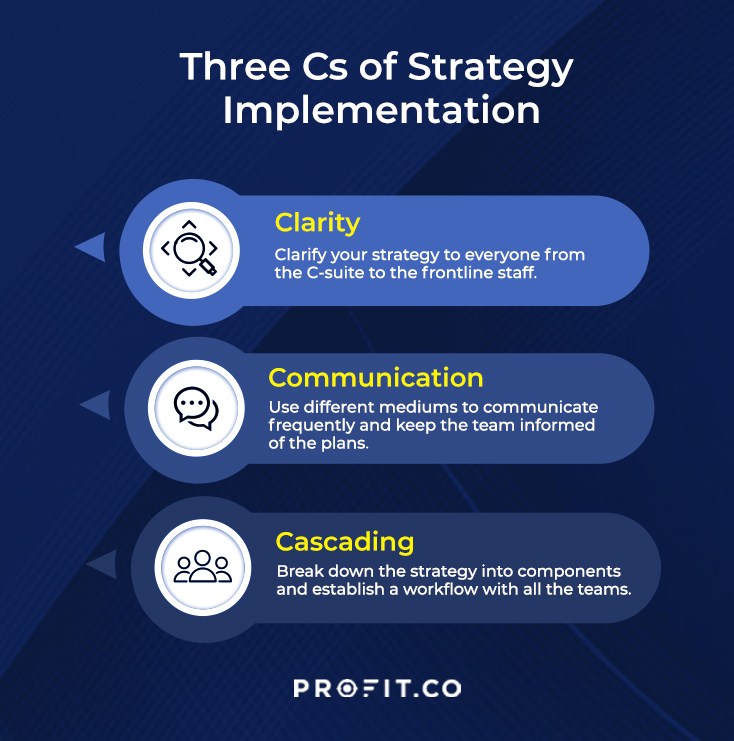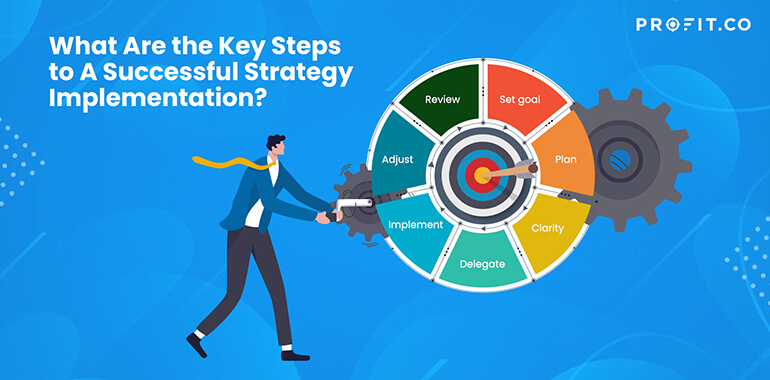A business manager’s key role is implementing strategy, but what does that mean? Even seasoned managers face challenges in strategy implementation for various reasons, from poor communication to lack of resources and resistance to change. This guide explores the best ways of implementing a strategy to give your business a competitive edge in your industry.
What Is Strategy Implementation?
Strategy implementation means turning a business plan into actionable steps to achieve your objectives. It’s how you get things done in your company to keep and maintain your bottom line. Implementing strategy means knowing your short- and long-term business goals, company structure, available resources, and market conditions.
What Are the Factors That Support Strategy Implementation?
A successful strategy implementation depends on five essential components:
1. Human Resources
You cannot implement a strategy without a workforce. Depending on your company type and size, the workforce can be a sole proprietor, an in-house strategy team, or an outsourced strategy execution expert. You need the right people with the right skills to act on your strategic plan. Consider upskilling your team to sharpen their strategy implementation skills and competencies.
2. Time and Money
Business strategy implementation needs a budget to include salaries, incentives, and strategy execution software subscriptions. You also need to allocate adequate time for each step of your business strategy, plus room for contingencies.
3. Clear Organizational Structure
Outline who is responsible for which step of your implementation strategic planning process. Know who everyone is accountable to, and open communication from top management to the lowest tier. Your team members must be completely aligned with the strategy. Otherwise, you risk poor communication and resistance to change, which slow down your business.
4. Strategy Implementation Tools and Systems
An Organization can choose to execute its strategy through the objectives and key results (OKR) framework. This framework has been used successfully by tech titans of our generation like Google, and Intel, etc. Companies can use an agile OKR software like Profit.co to implement the OKR framework and execute Strategy. The strategy implementation tools should be affordable, quick to deploy, easy to learn, and scale. You can get started on Profit.co completely free today!
5. Company Culture
Cultivate an organizational culture that values everyone’s input into business processes. You also want your team to be responsible, accountable, and motivated to contribute to the company’s mission. Implementing a strategy in a positive corporate atmosphere where employees understand their roles is much easier.

What Are The 3 C’s of Implementing Strategy?
Business leaders shoulder the burden of implementing strategy from creation to execution. To guide this process, keep the 3Cs of strategy implementation below:
1) Clarity
A high-level understanding of your business strategy isn’t enough for successful implementation. Clarify your strategy for everyone from the C-suite to the frontline staff. Use simple language and avoid corporate jargon. Explain your plan, how you’ll do it, and everyone’s role. This way, your team understands and resonates with your strategy.
2) Communication
When implementing a strategy communication is vital for its success. The secret is to use different mediums to get your plan across. For example, use internal message boards, podcasts, meetings, blogs, and other channels to keep your team informed. Open these channels for feedback for your team to chime in, offer suggestions, and troubleshoot the implementation steps if and when they face challenges.
3) Cascading
Cascading means breaking down the strategy into components that each team member contributes. When you cascade your plan, you reveal the practical parts of the strategy as they relate to everyday operations. A cascading strategy involves team and customer meetings, coaching and mentorship, streamlining workflows, product redesign, and responding to competitors. Cascading allows these actions to align with your company strategy for excellent results.
Strategy is simply resource allocation. When you strip away all the noise, that’s what it comes down to. Strategy means making clear cut choices about how to compete. You cannot be everything to everybody, no matter what the size of your business or how deep its pockets.
What Are the Steps Needed for Effective Strategy Implementation?
Let’s look at the practical steps involved in the strategic implementation process.
Step 1: Goal Setting
The first step of strategy implementation is defining your goals. This is where the OKR framework plays a critical role in your strategy. It also includes tracking your outcomes to reward your team and course-correct over time. OKRs are not tied to performance reviews or compensation but instead linked to your company’s mission and vision. An OKR typically has three or five objectives, with up to five measurable results for each purpose. OKRs tie your company goals to your overarching company vision in measurable and quantifiable steps.
Step 2: Human Resource Planning
This step involves identifying who does what at each implementation stage. Write out all the departments, teams, and employees, plus which goals and objectives they’re responsible for. Next, establish communication channels for your teams to minimize confusion during implementation. The key decision-makers in your strategy must be accessible to the frontline team for guidance when issues arise.
Step 3: Task Delegation
Always start with the big-picture strategy implementation plan, then break it down for your team using your OKR framework and timeline. Explain each task and its role in the strategy, then set a deadline to keep your team on target. With this approach, you avoid micromanagement and give your team more autonomy to manage their workloads as long as they meet the deadline.
Step 4: Actual Implementation
Once your team knows what they’re supposed to do, give the green light and begin your strategy implementation. This is the hardest part of the process since you must be available to answer questions and offer guidance at every stage as a manager. With the proper communication channels in place, you can check in with your team, track their progress, listen to feedback, and mark significant milestones at every step.
Step 5: Adjust and Revise Your Strategy
Implementing a strategy is a process that brings unforeseen challenges, but that doesn’t mean you stop altogether. You may discover that you need to redefine your goals or allocate more of your budget. You can also adjust your deadlines or reassign tasks to other team members until implementation is complete. A manager must be attentive, thoughtful, and open to change throughout strategy implementation. After all, this is how you learn about your strategy, team, and capabilities.
Step 6: Clarity on Completion
Say you’ve successfully managed the implementation process, and your project is complete. In that case, check in with your team to ensure you’ve met all your goals. Gather as much information as possible about the implementation process and agree on the project’s output. This helps you prepare reports about the implementation, the strategic planning process for your leadership team, and record-keeping purposes.
Step 7: Implementation Review
Doing a retrospective once you finish implementing the strategy is always helpful. The following questions offer clarity into your process:
- Did you set the right goals?
- Did you achieve those goals?
- Which goals did you miss or fail to implement?
- Which challenges and roadblocks arose during implementation?
- Which challenges were avoidable or could be anticipated?
- How did you overcome these challenges?
- What lessons did you learn from the implementation process?
Note: No manager wishes for failure, but flawed strategies are more common than you think. Even global brands like Kodak and eBay have suffered from failed business strategies. Use each challenge as a learning experience to improve future strategies.
Common Causes of Strategy Implementation Failure
To avoid wasting resources and opportunities, managers must understand the common underlying reasons why implementing strategy can go awry.
These include
- Misunderstanding the Strategy
- Separating Strategy from Core Business Functions
- Prioritizing Everyday Functions Over Strategy
Employees and managers must be on the same page right from the start and have transparent, effective communication channels. This allows for clarity and ownership, which improves motivation and empowerment when implementing strategy. Some strategies are also confusing or overwhelming. The OKR approach breaks down your goals into actionable portions for a user-friendly strategy.
Implementation of strategic planning involves budgeting, human resource management, employee compensation, customer relations, and many other business functions. Ensure that you link your strategy to these operational goals right from the start.
Business leaders often focus on daily business operations and overlook or dismiss their strategy. For example, strategy implementation may come up at meetings once or twice a month; then, the managers ignore it. If your strategy remains at the back of your mind, it’s easy to forget as you work on the bottom line.
Conclusion
Implementing a strategy is a challenge worth taking. It can streamline your business, identify your best talent, and accelerate growth. However, the difference between strategy success and failure lies in your approach. You must specify the right goals, allocate the right resources, and measure the right metrics at every implementation step. One reliable solution is the OKR framework. Objectives and key results help you to:
- Set ambitious, achievable goals
- Align teams and individuals to the right tasks
- Identify the necessary resources to achieve your goals
- Promote innovation and engagement
- Increase transparency and accountability
An OKR software like Profit.co is a tried and tested solution to support your strategy implementation. To learn more about how OKR software works, contact Profit.co or schedule your free demo today.

